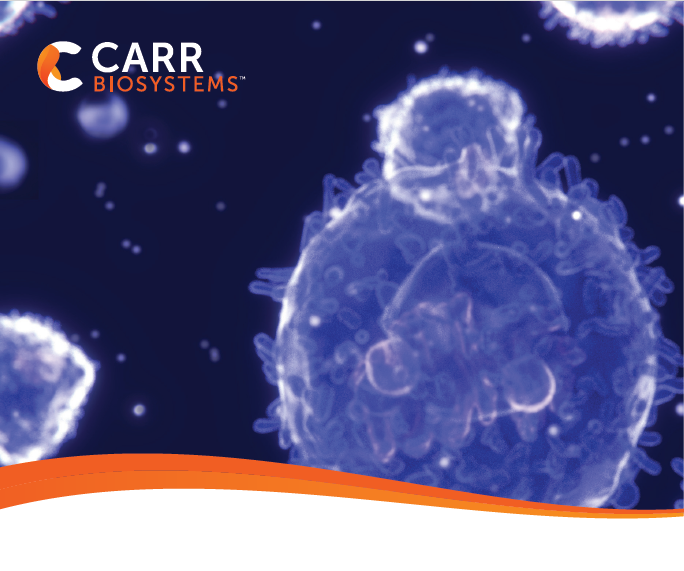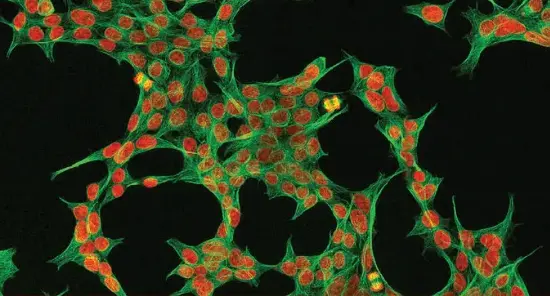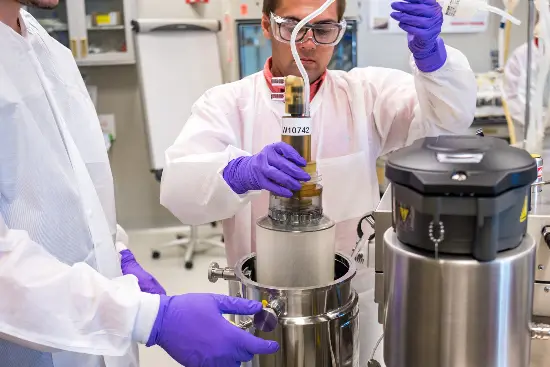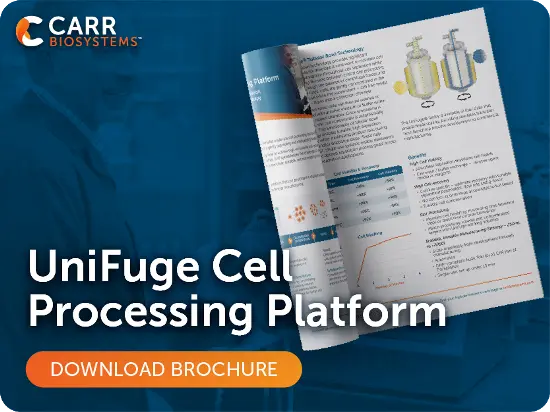Cell harvesting is crucial to the cell therapy manufacturing process, bridging the gap between cells’ optimized growth environment and a final formulation that retains their potency and efficacy. The number of variables that impact harvesting, coupled with the complexities introduced by the unique CQAs of each cell therapy and the fragility of many emerging cell types, can result in a challenging balancing act that requires significant expertise to navigate.
Achieving optimal cell harvest is important across the development continuum and at every phase of scale-up. While unique challenges exist for all cell therapies, optimizing harvest conditions for allogeneic cell therapies comes with unique considerations to achieve the manufacturing scales required for these promising innovations. Enabling the yields, reproducibility, and larger production volumes necessary to support allogeneic applications will be key to addressing some of the core challenges that have limited their commercialization potential in the past. Much of this optimization centers on standardizing equipment and processes early in development; establishing growth environments, media, and mixing that support improved cell viability; and closing, validating, and (where appropriate) automating workflows. Maintaining critical process parameters (CPPs) such as viability and recovery often requires technologies that provide scalability, automation, and the flexibility to tune processes to achieve cell- and therapy-specific critical quality attributes. For many applications, cutting-edge centrifugation technologies can help achieve this optimization, affording developers and manufacturers a low-shear, high-yield cell harvest that is tightly controlled and highly reproducible.
For many organizations in the early stages of development, manual processing is often the most accessible and appropriate approach to demonstrating an investigational candidate’s promise. However, as a therapy progresses through development, many of these early, hands-on approaches become incompatible with GMP manufacturing processes and highly inefficient to scale. Moreover, the longer a company waits to transition its processes, the more difficult this proposition becomes. While many organizations may reason that a unique asset, with unique process requirements, necessitates they develop a new (often manual) process from scratch, the reality is that by identifying suppliers with the expertise and scalable solution portfolio to support optimized cell harvest, cell therapy developers can ensure that their processes are primed for efficiency, reproducibility, and safety at scale.
Prioritizing Late-Stage Goals to Support Successful Cell Therapy Development
When it comes to the specific CQAs associated with a therapy, for example cell viability, the chief variables at work are tied to a cell’s environment, whereby access to nutrient and oxygen and stress imparted by reagents, temperatures, and handling procedures all converge to determine the ultimate viability of a workflow. During cell expansion, it is well understood that optimizing cells’ access to nutrients, balancing the shear stress occurring inside the culture vessel, and managing waste can demand very different approaches, depending on the cell type in question. Similarly, during cell harvest, these environmental conditions must be optimized appropriately for a given cell therapy. While microbial cells like E. coli and certain engineered mammalian cells like CHO are fairly robust, many other cell types common to advanced and emerging therapies, such as T cells, stem cells, and natural killer (NK) cells, are much more sensitive to factors such as shear stress. This sensitivity can often drive developers to adopt preclinical and early clinical approaches that are highly manual.
These manual and often open-system approaches may work in navigating early development but are often unsustainable or unnecessarily risky at greater scales. By introducing scalable technologies that eliminate as much manual and open processing as possible in early development, companies can position themselves for manufacturing that is safer, faster, and far more cost-effective. Partnering with suppliers that can facilitate scalable automated and closed processing – and offer the flexibility necessary to meet the unique needs of a bespoke process – can help companies further optimize processes to meet the needs of their unique asset as they scale toward commercialization.
It can be difficult to pinpoint the right time to start transitioning a process away from open and manual operations and implement more closed and automated processes that ensure consistency and safety. While this decision is often dependent on the unique variables that accompany a project, the leap from preclinical to clinical development is often one of the better opportunities to undertake this evaluation without adding significant regulatory burden. This approach may represent a heavy lift for organizations with limited resources to fund process development, but the potential for added downstream costs is a key factor in this decision. Continuing to scale out small-process-volume or inefficient operations can have sweeping ramifications as developers run headlong into regulatory constraints best mitigated by a transition to appropriately scaled production processes. Avoiding these pitfalls is often best accomplished by engaging in early evaluation and identifying the technologies best suited to scaling a process to meet its late-stage goals.
Separation Systems Best Suited to Allogeneic Cell Therapies
The question of scaling to high-volume production is one that is relatively new to the cell therapy space. The majority of cell therapies available on the market today are autologous, meaning that each dose is produced using a donor’s own cells. This sort of “one-batch-one-patient” approach has largely precluded the need to aggressively pursue large-batch production. It has, however, resulted in the development of standardized and automated solutions, geared toward safeguarding these costly and critical interventions. Similarly, applying fit-for-purpose innovations to allogeneic cell therapy production while working to enable the larger production scales necessary for patient populations will likely prove a decisive factor in shepherding more allogeneic applications through the clinical pipeline.
As more allogeneic cell therapy applications enter the development pipeline, the emergence of specialized bioprocessing equipment, purpose-built to support viable cell harvest, will represent a critical component supporting their proliferation. This is where separation systems tailored to enable the right conditions for these highly specialized cell types are crucial to maintaining cell viability during harvest, as well as supporting optimal cell recovery. At the scales most commonly targeted for an allogeneic therapy, achieving the necessary viability and recovery is largely only achievable with fluidized bed or tubular bowl centrifugation.
Selecting A Separation Technology – Maximizing Cell Viability and Recovery
When separating cells during the production of a cell therapy (whether for harvest, media exchange, cell washing, or formulation), achieving a high cell recovery (the % of cells captured) and maintaining cell viability are paramount to a successful unit operation. Selecting a low-shear technology such as a tubular bowl centrifuge is a requirement to achieve high cell viability; however, attention must be paid to factors such as processing time and cell health prior to separation which can significantly impact viability. Processing time is critical in nearly all cases because the separated (and concentrated) cells have reduced access to oxygen and cell death can occur if processing times extend too long. In the case of processing stressed cells – such as transfected HEK or electroporated stem cells – additional caution must be taken to run processes at the gentlest conditions, often using the lowest possible g-forces to further reduce the potential for shear. Even the determination of cell viability or health must be carefully considered, as cells that are deemed viable through analytical methods such as trypan blue staining may be stressed or altered in ways undetectable by these methods.
Similarly, maximizing cell recovery requires careful consideration, and in some cases, overall process optimization requires trade-offs between recovery efficiency, cell viability, and processing times. For example, at a given g-force optimized for cell viability and health, the processing speed may need to be reduced to achieve the desired recovery efficiency or increased to maximize cell health. These parameters can be balanced to achieve the desired critical process parameters and therapeutic critical quality attributes, however, care must be taken to understand the benefits and risks of the chosen cell capture technology. As systems are pushed to operate closer to the edges of their processing windows, inherent risks with specific technologies become more apparent. In the case of counter-flow configurations (including those often found in fluidized bed centrifugation), for instance, perturbations in flow rate can result in total loss of harvested cells when set point flow rates approach, and perturbations exceed, settling velocities. These and other factors are best assessed through consultation with experienced suppliers that understand how these therapy- and process-specific factors can be accommodated through process optimization of the considered separation technology.
Finally, there are many other aspects of a separation technology that should be assessed during the selection process in order to de-risk the commercialization of an allogeneic cell therapy. These include (a) if the environment is closed and scales from early clinical stages to commercialization, (b) if the system enables automated or semi-automated processing, (c) if the system combines harvest, media exchanges, cell washing, and other operations in a single closed system, and (d) if the system offers the flexibility to tune critical process parameters to address unique therapeutic critical quality attributes and process-specific requirements.
Cell Harvest That Enables Scale for Allogeneic Applications
For allogeneic therapies, achieving high cell densities and the ability to harvest and formulate while maximizing the recovery of viable and healthy cells is crucial to optimizing production and ensuring efficacy for these impactful drug products. The relative scale needed to support future allogeneic applications makes cell harvest technologies that are highly manual and utilize open systems designed for laboratory scale, ill-adapted for commercial production. Likewise, high-shear technologies must be avoided for these applications, which require gentler cell environments to achieve their full production potential. While systems designed for scalable cell harvest, media exchange, and cell washing are available, consultation with expert suppliers can streamline processes and reduce the efforts required by cell therapy manufacturers to properly implement and optimize these technologies. Although it is highly preferable to introduce these technologies during the early development and clinical phases, implementation of these versatile systems can be achieved at later stages if needed to address process or regulatory concerns that may not be apparent until later in the clinical development. Ultimately, the commercialization of allogeneic cell therapies is profoundly benefited by the implementation of a separation technology that maximizes cell health while enabling simpler scaling, greater automation, and a high degree of process control.
About Us
CARR Biosystems offers single-use and stainless steel separation systems, delivering high-performance, fully scalable bioprocessing solutions to accelerate process development. We help scientists and engineers produce vital biologics, including cell and gene therapies, vaccines, monoclonal antibodies, and cultivated meats.





